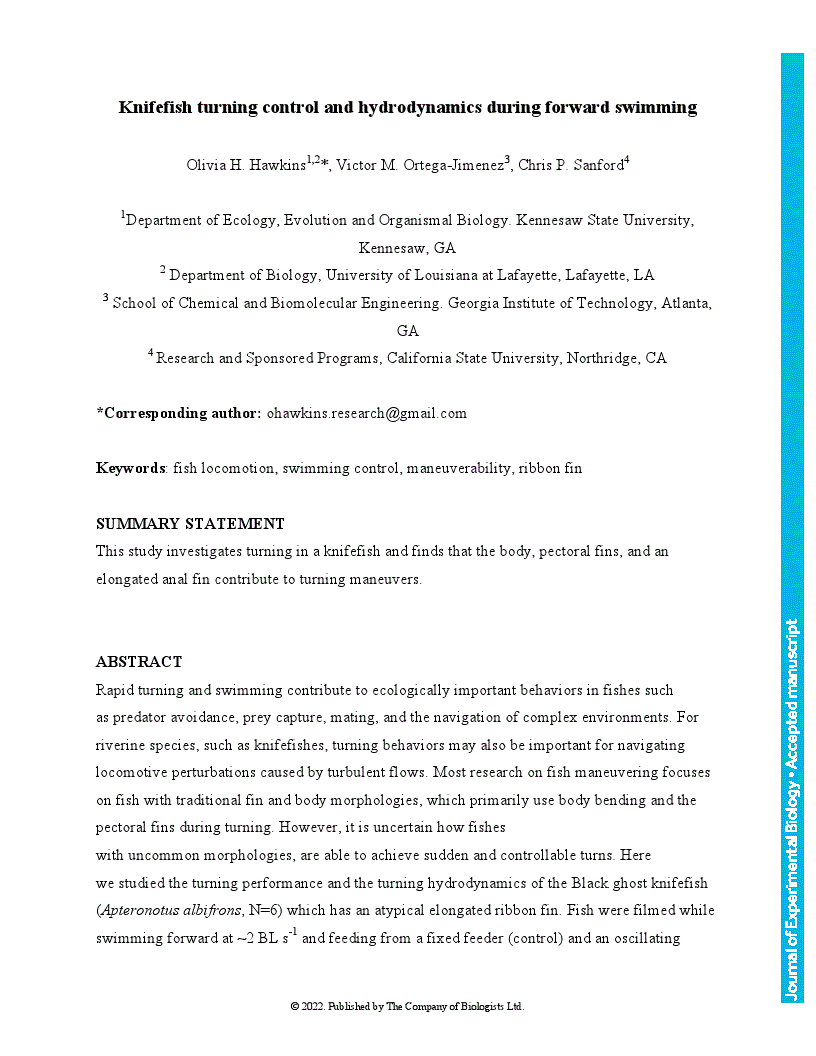Rapid turning and swimming contribute to ecologically important behaviors in fishes such as predator avoidance, prey capture, mating, and the navigation of complex environments. For riverine species, such as knifefishes, turning behaviors may also be important for navigating locomotive perturbations caused by turbulent flows. Most research on fish maneuvering focuses on fish with traditional fin and body morphologies, which primarily use body bending and the pectoral fins during turning. However, it is uncertain how fishes with uncommon morphologies, are able to achieve sudden and controllable turns. Here we studied the turning performance and the turning hydrodynamics of the Black ghost knifefish (Apteronotus albifrons, N=6) which has an atypical elongated ribbon fin. Fish were filmed while swimming forward at ∼2 BL s−1 and feeding from a fixed feeder (control) and an oscillating feeder (75 Hz) at two different amplitudes. 3D kinematic analysis of the body revealed the highest pitch angles and lowest body bending coefficients occurred during steady swimming. Low pitch angle, high maximum yaw angles and large body bending coefficients were characteristic of small and large turns. Asynchrony in pectoral fin use was low during turning, however ribbon fin wavelength, frequency, and wave speed were greatest during large turns. Digital particle image velocimetry (DPIV) showed larger counter-rotating vortex pairs produced during turning by the ribbon-fin in comparison to vortices rotating in the same direction during steady swimming. Our results highlight the ribbon fin's role in controlled rapid turning through modulation of wavelength, frequency, and wave speed.
Knifefish turning control and hydrodynamics during forward swimming
- Award Group:
- Funder(s): Kennesaw State University College of Science and Mathematics
- Funder(s):
Currently Viewing Accepted Manuscript - Newer Version Available
- Split-screen
- Views Icon Views
- Open the PDF for in another window
-
Article Versions Icon
Versions
- Version of Record 04 April 2022
- Accepted Manuscript 25 February 2022
- Share Icon Share
-
Tools Icon
Tools
- Search Site
Olivia H. Hawkins, Victor M. Ortega-Jimenez, Chris P. Sanford; Knifefish turning control and hydrodynamics during forward swimming. J Exp Biol 2022; jeb.243498. doi: https://doi.org/10.1242/jeb.243498
Download citation file:
Advertisement
2023 JEB Outstanding Paper Prize shortlist and winner

The JEB Editors are delighted to announce the shortlisted authors for the 2023 JEB Outstanding Paper Prize. Read the winning paper - Tiny spies: mosquito antennae are sensitive sensors for eavesdropping on frog calls - by Hoover Pantoja-Sanchez and Brian Leavell from Ximena Bernal's lab at Purdue University, USA.
JEB Science Communication Workshop for ECRs

If you’re an early-career researcher interested in science communication and are attending the SEB Annual Conference in Prague this summer, come a day early and join the JEB Editors at a sci comm workshop to learn the key writing skills needed to promote your research to a broad audience beyond your peers (1 July at 14.30-17.30). Places are limited to 24 attendees, and applicants should apply through the SEB registration page by 30 April 2024.
Bridging the gap between controlled conditions and natural habitats in understanding behaviour

Novel technologies enable behavioural experiments with non-model species, in naturalistic habitats and with underexplored behaviours. In their Commentary, Scholz and colleagues discuss how to obtain a deeper understanding of the natural ecology and lifestyle of study animals.
Beluga metabolic measures could help save species

To help save animals from extinction, it’s important to understand what each species needs to survive. This led Jason John et al. to measure the metabolic rates of captive belugas to develop a ‘fish calculator’ showing that the whales need to eat ~23 salmon per day.
ECR Workshop on Positive Peer Review

Are you an ECR looking for tips on how to write concise, astute and useful manuscript reviews? If so, join the JEB Editors at a 2-hour JEB-sponsored Workshop on Positive Peer Review at the Canadian Society of Zoologists annual meeting in Moncton on 9 May 2024 at 13.00-15.00. There are 25 spaces for ECRs and selection is first come, first serve. To sign up, check the ECR Workshop box when you register for the CSZ meeting.



